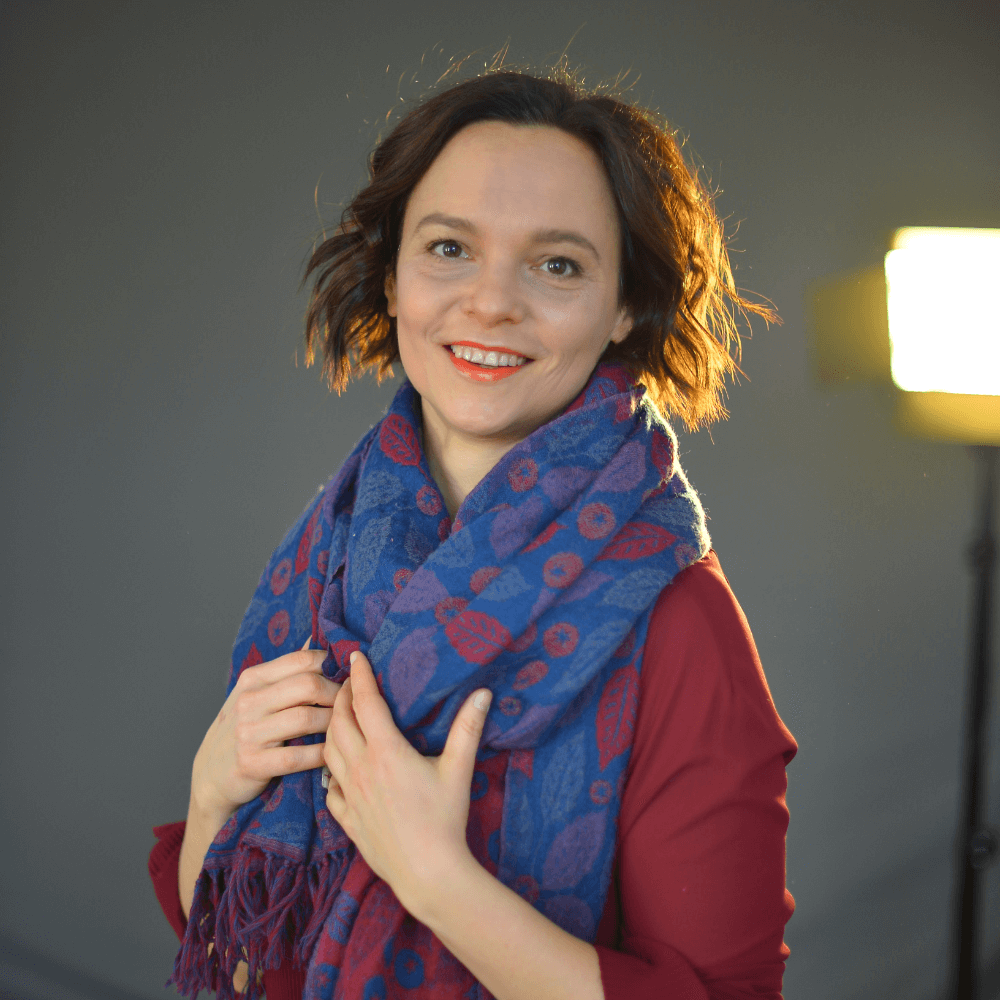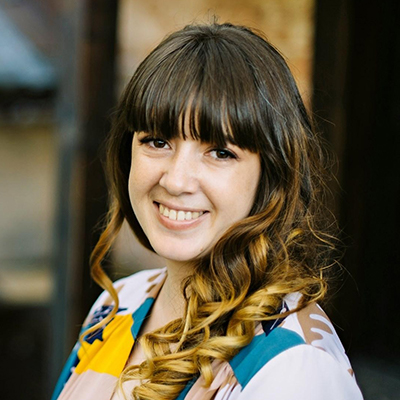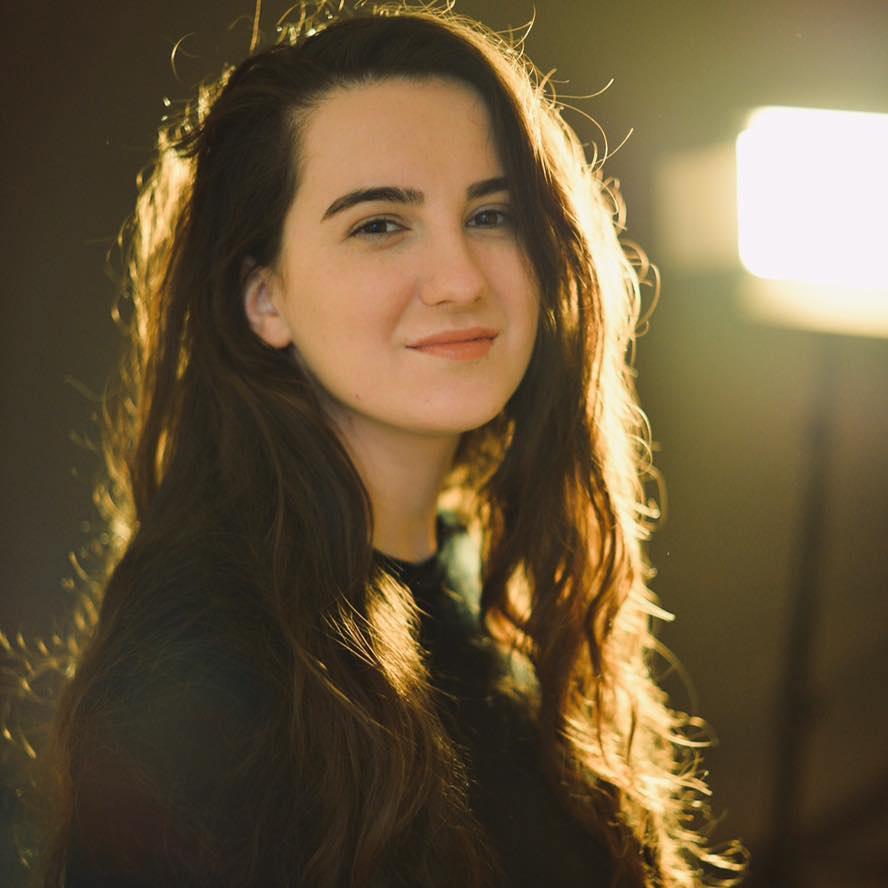In 2021, the children who were 10 years old when Russia occupied Crimea and parts of the Donetsk and Luhansk regions will apply to universities. These are the citizens of Ukraine in captivity in the occupied territories because they could not leave without their parents, due to their age. Government officials have repeatedly said, that getting the children back form the TOT is part of our state’s policy. But are these children really welcome in Ukraine? While many people discuss the risks of enrollment of the children from the TOT on public platforms, emphasizing their low level of preparation, our analysis shows that it is a myth.
TOT – the temporarily occupied territories
DNR and LNR – the quasi-states in the Donetsk and Luhansk regions
ORDLO – the temporarily uncontrolled territories of Luhansk and Donetsk regions
ZNO – external independent evaluation in Ukraine
HEI – higher education institutions
Since the occupation, more and more barriers have arisen to the children’s preparations and enrollment in Ukrainian universities. Because they study in Russian at schools, studying history of the so-called “DNR” and “LNR” instead of history of Ukraine. Consequently, to obtain a Ukrainian certificate of secondary education required for admission, the children must finish a Ukrainian school remotely or as external students, as well as cross the line of contact to take ZNO tests. In 2020, it was particularly difficult due to the restrictions related to the COVID-19 pandemic. The occupying power hampers travel for the children willing to study at Ukrainian universities, making it difficult for them to leave the TOT, exerting psychological pressure, persecuting their families.
But they are Ukrainian citizens and their right to education, including higher education, is enshrined in Article 53 of the Constitution.
According to the Unified State Electronic Database on Education (USEDE), over 214 thousand students enrolled in Ukrainian higher education institutions in 2020. Among them, only around 3 thousand come from the occupied territories in the Donetsk and Luhansk oblasts and Crimea. It is a little less than 1.5% of all applicants and a little more than 10% of all 11th-graders who graduated from schools in the occupied territories this year. Only two thirds made use of preferential enrollment conditions via the educational centers (Graph 1).
Starting from 2020, the quota for the children from the TOT (i.e. Quota 2) has to be 10-20% of the state-funded places at all Ukrainian universities, making it possible to enroll under a simplified procedure (obtaining a school certificate quickly based on two exams (Ukrainian and History of Ukraine) and taking exams at the university in lieu of ZNO tests). If they so wish, the applicants can use their certificate of secondary education from a Ukrainian school and ZNO scores.
Although these rules should apply to all universities, in reality, it is possible to enroll under a simplified procedure in the universities that have already created the educational centers “Crimea-Ukraine”, “Donbas-Ukraine”. As of January 2021, 195 institutions of higher and vocational pre-university education (colleges, technical schools, medical schools) have created the educational centers, which is nearly one third of the total amount of such institutions.
Graph 1. Number of persons enrolled in Ukrainian higher education institutions via the educational centers, 2016-2020
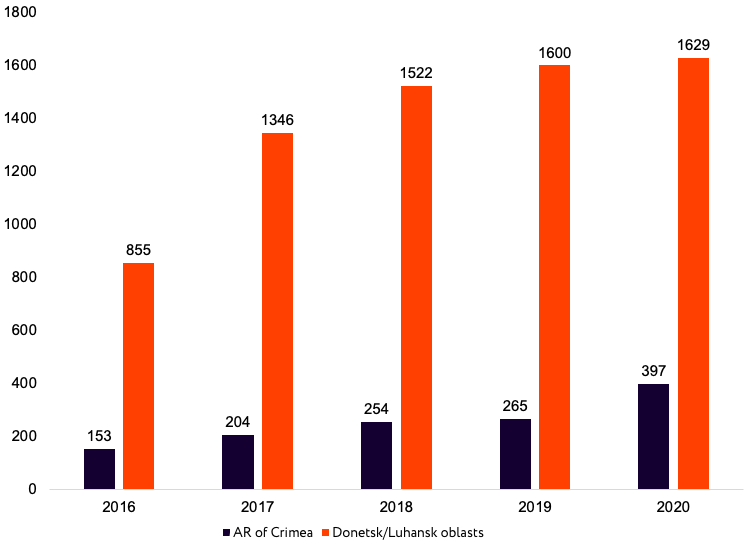
Data: The Ministry of Education and Science of Ukraine
There are many reasons why children from the temporarily occupied territories almost do not enroll in Ukrainian HEIs: hostile propaganda, a myth about “getting killed in Ukraine for speaking Russian”, a lack of information about the admissions requirements and privileges for the children from the TOT, and the high costs of travel from the occupied territories and lodging in Ukrainian cities during the admissions process caused by a stiff property qualification.
In the government-controlled areas, children from the TOT often face hostile attitudes. The most widespread stereotype is the following: “the separatists will come and take the places away from the talented Ukrainian children”. Such statements are actually unfounded.
The level of knowledge of children from the TOT is not lower than that of other applicants
The quantitative part of our study is based on the data from USEDE. The database contains information about 1,284 students enrolled under Quota 2. At the same time, the Ministry of Education and Science of Ukraine (MoES) informs about 2,026 children who used the quota. We think that the discrepancy has to do with an imperfect process when some children are first enrolled on a contract basis and then transferred to the state-funded places under Quota 2. Specifically, the entire second wave of the applicants from the TOT (August 22 – October 23) got enrolled under this scheme. Below we took into consideration only the students enrolled under Quota 2 in the first wave as provided in USEDE.
The comparisons below are based on the assumption that the procedures for conducting and assessing entrance exams take place in the same way at all universities, making it possible to correctly assess the students’ level of knowledge. Unfortunately, we cannot examine the accuracy of this assumption.
The results of our study suggest that the entrance scores of the students who used the quotas for the children from the TOT are way above the average scores of the other applicants to Ukrainian universities on a contract basis and are a bit lower than the average scores of those enrolling into the state-funded places (Graph 2). However, Graph 2 shows that some children from the government-controlled areas who enrolled into the state-funded places had lower scores than the applicants under Quota 2.
Graph 2. Average entrance score of the students in 2020
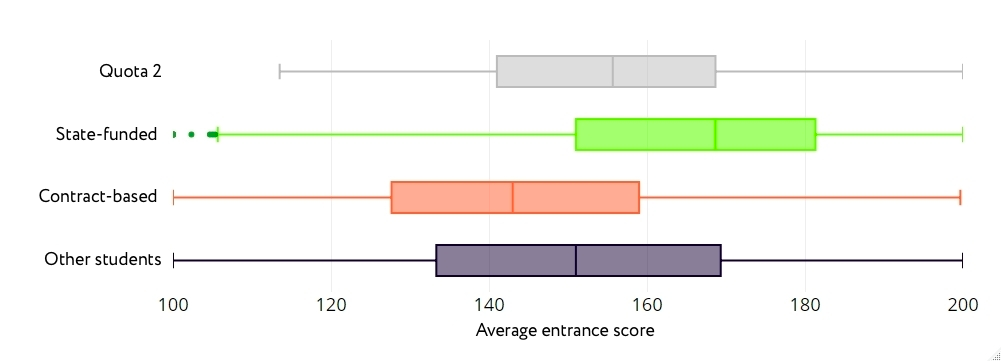
By “other students” we mean the students studying in the state-funded places or on a contract basis, not eligible to Quota 2. Source: The Unified State Electronic Education Database, data as of Dec. 22, 2020, the authors’ calculations
About 60% of the children who used the quota could enroll into the budget-funded places in their chosen specialties at their chosen universities without the quota (Graph 3). The other 40% would not have gotten into their specialties on a competitive basis but could have a chance to enroll in other universities or specialties.
Graph 3. The difference between the final score of the students enrolled under Quota 2 and the minimum passing score for the budget-funded places in their specialties at their universities

Source: The Unified State Electronic Education Database, data as of Dec.22, 2020, the authors’ calculations
That is, most applicants from the TOT had quite high scores and they could enroll into state-funded places at Ukrainian universities without additional privileges.
During the admissions process, a big advantage to the children from the TOT was not the available state-funded places but an opportunity to use a simplified procedure for obtaining a school certificate and taking entrance exams – because the occupation authorities blocked the exit from the occupied territories on the eve of ZNO testing.
Admissions under a simplified procedure, when all necessary exams can be passed in 1-5 days, makes it possible to reduce the number of times of crossing the line of contact and decrease the risk of being persecuted by the occupation powers. It also makes the admissions process shorter and helps save on lodging during admissions season.
Children from the TOT are very motivated
When deciding in favor of Ukrainian education institutions, the children from the TOT have to be ready to overcome negative attitudes from those around them both in the occupied territories and in the government-controlled areas, as well as the risk of persecution by the occupation authorities. Therefore, only those who really want it, apply to universities.
“I was very much surprised that people may have different views on certain subjects but can do something together and not have internal censorship in their conversations about politics. I was overwhelmed by it. There’s more freedom here.” – a student, 19.
“Talking about applying for college in Ukraine is equated [in Crimea] to a criminal offense.” – a female student, 17.
Source: in-depth interviews with the students from the TOT, the report “Through the thorns to knowledge. Evaluation of the implementation of the state support for applicants to Ukrainian universities from Crimea and occupied territories of Donetsk and Lugansk oblasts”
Unlike most Ukrainian children, students at Crimean and ORDLO schools have to make a lot of effort to study the Ukrainian language, literature, and History of Ukraine on their own. Even if Ukrainian was taught in school, most of the instruction is in Russian making it necessary for them to learn the terminology for ZNO tests in mathematics, physics, chemistry, or geography on their own or with the help of tutors.
The interviews with the applicants showed their responsible attitudes toward enrollment in Ukrainian universities. All of our respondents used the services of a tutor in at least one subject. In addition to their principal school, most of them also studied at a Ukrainian school remotely and took online courses in preparation for ZNO tests. During the interviews, most of the respondents said they preferred to take ZNO tests in Ukrainian because they used it to prepare for the exams. They also explained their motivation to study Ukrainian by their future plans to build a successful career in Ukraine.
“When in the 11th grade, I was told I had to finish the 9th grade in a Ukrainian school, so I had to do 3 years in one.” – a female student, 17.
Source: in-depth interviews with the students from the TOT, the report “Through the thorns to knowledge. Evaluation of the implementation of the state support for applicants to Ukrainian universities from Crimea and occupied territories of Donetsk and Lugansk oblasts”
Besides the tutors, the applicants spend a lot on travel and lodging.
As there is no official transportation from the occupied territories to Ukrainian cities in the government-controlled areas, the applicants have to use the services of private transporters whose prices are usually quite high. The children often travel to the government-controlled areas accompanied by one of their parents, which doubles the cost.
Crossing the line of contact can hardly be called pleasant. Some respondents spent several hours or even over 24 hours at the checkpoint. One of the respondents said he had come under fire at the checkpoint. In addition to physical inconveniences, children face psychological pressure: they can be persuaded not to enroll in Ukrainian HEIs (being told that there are also educational institutions in the occupied territories), their belongings can be searched, their photos and mail messages on the phones and computers can be checked. Sometimes, it borders on absurd – for example, one of the respondents had to explain at the checkpoint why he was wearing an orange cardigan.
“If you say you’re going to study, you get asked a lot of questions, they say we’ve got a big country, what exactly couldn’t you find here?” – a female student, 17.
Source: in-depth interviews with the students from the TOT, the report “Through the thorns to knowledge. Evaluation of the implementation of the state support for applicants to Ukrainian universities from Crimea and occupied territories of Donetsk and Lugansk oblasts”
Another significant item of expenditure is accommodations. In 2020, the occupying power of Crimea allowed Crimeans only one trip to the government-controlled area. Therefore, the children who came to take ZNO tests had to rent lodging until the results of the entrance exams were announced.
The situation at the checkpoints with ORDLO was also uncertain and the applicants did not take the risk of returning home, fearing they would no longer be able to leave for the government-controlled areas again. During the interview, they estimated their costs during the admissions process at UAH 15-25 thousand. It is obvious that, when applying to educational institutions located in the border areas, it is possible to save a little on travel and rent. Sometimes, the applicants choose to enter universities in the cities where they have relatives.
“If I go home now, I’m not sure I can get back here again.” – a female student, 17.
“At the time of admission, I had virtually no place to live. I lived at my friends’ place for a while, then hiked for a few months all over Ukraine and lived in a tent.“- a student, 19.
Source: in-depth interviews with the students from the TOT, the report “Through the thorns to knowledge. Evaluation of the implementation of the state support for applicants to Ukrainian universities from Crimea and occupied territories of Donetsk and Lugansk oblasts”
Conclusions
The children from the TOT who applied in 2020 do not have lower entrance exam scores than the children from the government-controlled areas. In 2020, the quota granted admissions preferences to 40% of students from the TOT. The rest had the scores that would enable them to enroll into the state-funded places to their chosen specialties at their universities on a competitive basis. Practically all children from the TOT spent extra hours studying Ukrainian and history, either with a tutor or remotely at a Ukrainian school. Therefore, we can say that these children are very motivated and are an asset to the universities rather than a burden.
The main problem during their enrollment is communication. It is important to explain to society why the state pursues the policy of supporting applicants from the TOT and what it is about. Because if we want to eventually get the occupied territories back, it is worth helping the people from there. The students from the TOT is one of the “connections” of the Ukrainian state with the occupied territories. This connection should be strengthened.
The article is based on the report ”“Through the thorns to knowledge. Evaluation of the implementation of the state support for applicants to Ukrainian universities from Crimea and occupied territories of Donetsk and Lugansk oblasts” created as part of the German Ukrainian Researchers Network (GURN) project, with financial support from Institute for European Policy under a grant from the Foreign Office of the Federal Republic of Germany. The project is implemented at the initiative of the Institute for European Politics (Berlin) together with the Ilko Kucheriv Democratic Initiatives Foundation, New Europe Center and think twice UA. The contents of the material are the exclusive responsibility of VoxUkraine and does not necessarily reflect the position of the Federal Foreign Office of Germany. The material was selected as part of the research projects contest held under the GURN project by the Institute for European Politics in close collaboration with the Ilko Kucheriv Democratic Initiatives Foundation. The report is based on data from MoES, USEDE, and in-depth interviews with students from the TOT, university and MoES representatives.
Attention
Автори не є співробітниками, не консультують, не володіють акціями та не отримують фінансування від жодної компанії чи організації, яка б мала користь від цієї статті, а також жодним чином з ними не пов’язаний
